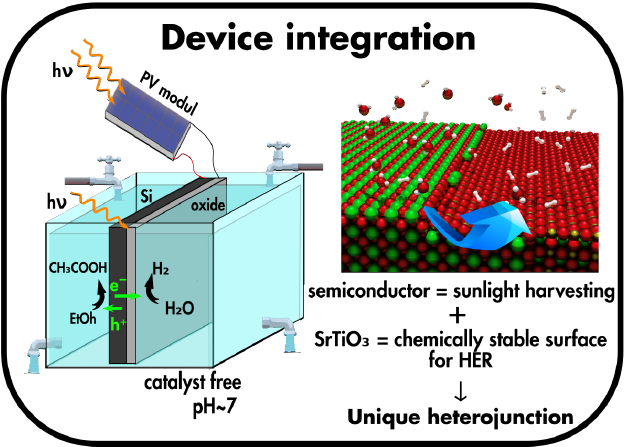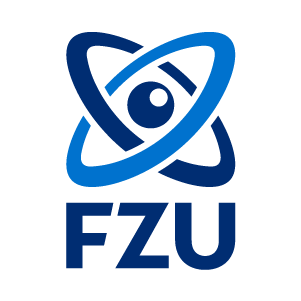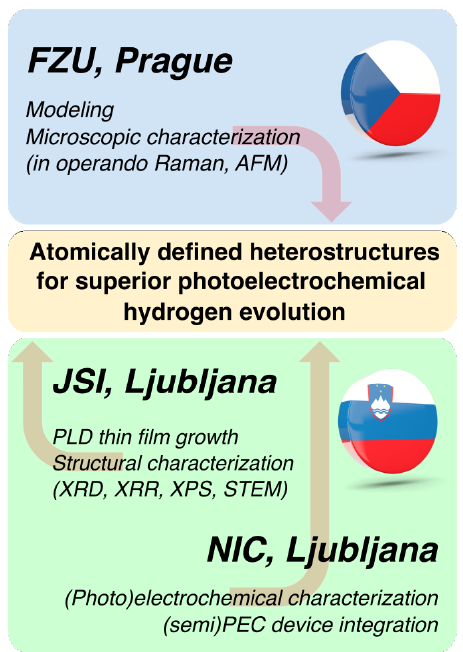Light and neutron scattering
Project no. 24-10699K of the Czech Science Foundation
Tailoring Relaxor Antiferroelectric Ceramics for Energy Storage (TRACES)
E. Buixaderas, (2024-2027)
(show abstract)
Producing energy from renewable sources imposes challenges related to storing a constantly fluctuating energy. The development of innovative materials for high-energy storage with good temperature stability is therefore essential for applications in electric vehicles, aeronautics, geothermal energy exploitation, etc. Nowadays, no material completely meets the current industrial requirements. Recent models describing the energy density and efficiency of antiferroelectric materials provide an encouraging guidance towards achieving good storage properties in small, light, inexpensive, and environmentally-friendly components. In this interdisciplinary bilateral Czech-Slovenian project we propose to develop new environment-friendly, lead-free relaxor antiferroelectric materials and to design proof-of-concept multilayer capacitors on the basis of lattice-dynamics and structure-property characterization of materials across multiple length-scales, supported by simulations and modelling.
(hide abstract)
Project no. 101130758, EU-Horizon Europe, MSCA
Dynamics of water next to solid-state surfaces and polymers (ATTIC)
A. N. Theodorou, (2023-2025)
(show abstract)
Despite numerous studies of liquid water, its molecular structure has not yet been fully resolved and understanding of its
specific properties remains limited. Recent experimental and theoretical studies have shown that interfacial water
formed on surfaces of various synthetic materials tends to exhibit long-range order. Specifically, water exhibits
unique physicochemical properties next to the super hydrophilic Nafion surface such as the exclusion of solutes and
microspheres, higher refractive index and viscosity, absorption at 270 nm, and charge separation susceptible
to incident electromagnetic energy. Ordered layers of water molecules have been also found next to biomolecules
like proteins or DNA suggesting a dynamic interaction between matter and aqueous media based on hydrogen bonding or
other electrostatic interactions. Simulation studies have also shown that water adjacent to graphene surfaces could build
an extensive hydrogen bond network suggesting that water might be involved in the p–p interactions between aromatic groups.
In the ATTIC project, the water layer built in the vicinity of various surfaces will be extensively investigated
at a molecular level by employing dielectric, THZ and Raman spectroscopic techniques.
The spectroscopic studies will be initially focused on Nafion and other hydrophilic surfaces and subsequently,
the interactions of water with the aromatic groups of graphene will be explored.
The last part of the project includes spectroscopic studies next to orthogonally synthesized styrene-based polymers that
bear different functionalization to explore how alterations in the electronic density of aromatic groups affect
the water dynamics and the overall self-assembly state of polymers in water.
This project aims to bridge the gap between diverse experimental and theoretical works on unique water properties and
to pave the way for the development of innovative water-based technologies.
(hide abstract)
Past projects:
Project no. LAS-21-02 of the Czech Academy of Science - Mobility Projects
High frequency dielectric response of uniaxial relaxors and ferroic materials
E. Buixaderas, (2021-2023)
(show abstract)
The project will study the high frequency ferroelectric response (mainly above 1 MHz) and lattice dynamcs of several relaxor and
ferroelectric materials, in order to understand the important microwave range (1-100 GHz), where relaxation processes
at the mesoscale takes place. This is important to understand the conection between macroscopic properties, like permittivity,
and the microscopic atomic structure. We will focus in iniaxial relaxor materials like SrBaNb2O6 and similar,
but also in ferroelectrics based on BaTiO3 and PbTiO3, because all of them show responses in the 10-100 GHz range,
that were not properly studied and understood up to now. The experiences and techniques of our department and
the partner organization will complement to cover the broad band multiexperimental approach needed.
(hide abstract)
Project no. 21-20110K of the Czech Science Foundation - International Lead Agency
Semiconductor - dielectric heterostructures for photoelectrochemical hydrogen evolution (SeDiHe)
J. Hlinka, (2021-2023)
(show abstract)

SeDiHe, a joint Czech - Slovenian research project, focuses on photoelectrochemical (PEC) water splitting for H
2
generation from heterostructures that combine a protective oxide layer (POL) with a semiconductor.
We propose a radically new approach to assemble these two dissimilar material systems in order to create an atomically defined interface.
The idea is based on nanostructuring using a graphene oxide (GO) layer, which should have a crucial role in van der Waals epitaxy
between the constituents, as well as their electronic coupling. The heterostructures are integrated into semi-PEC reactors,
where a photovoltaic (PV) cell supplies an additional external voltage to achieve H
2 production.
Success of this strategy requires detailed knowledge of:
- the key parameters contributing to higher efficiency of H2 generation from PEC water splitting, such as defect concentrations and atomic structure of the interface,
- options to engineer band offsets using various dielectric POL materials,
- factors limiting solar-to-hydrogen (STH) efficiency of semi-PEC reactors made of these novel heterostructures.
Research partners
- Department of Dielectrics , Institute of Physics of the Czech Academy of Sciences, Prague, Czech Republic
- Advanced Materials Department , Jožef Stefan Institute, Ljubljana, Slovenia
- Laboratory for Electrocatalysis , Department of Materials Chemistry, National Institute of Chemistry, Ljubljana, Slovenia
Contacts
(hide abstract)
Project no. 19-28594X of the Czech Science Foundation
Ferroelectric skyrmions
J. Hlinka, (2019-2023)
(show abstract)
Domain walls in ferroelectrics are naturally formed 2D solitons with a defined, nm-thick
polarization profile stable over macroscopic lateral dimensions. Strong coupling of the
polarization gradient with strain drastically changes the material properties within the domain
wall thickness. Increasing attention is paid to these mobile interfaces because the
characterization tools have recently reached the desired nanoscale resolution, needed to
uncover the rich spectrum of new phenomena expected there. We are convinced that some
ferroelectrics can also host 1D analogues of domain walls, i.e. spontaneously formed
ferroelectric line solitons, similar to the recently experimentally confirmed Bogdanov-Yablonskitype
magnetic skyrmion lines. We wish to extend the explorations also to these interesting
topological objects and to pave a path to the experimental discovery of the ferroelectric
skyrmion phases, analogous to the vortex states in superconductors and skyrmion phases of
chiral magnets.
(hide abstract)
Project no. 21-19073J of the Czech Science Foundation - International Bilateral
Multicaloric phenomena in novel single-phase and composite materials based on complex oxides
P. Ondrejkovic, (2021-2023)
(show abstract)
Caloric effects of ferroelectric and ferromagnetic materials have recently received significant attention in solid-state cooling. The electrocaloric effect in bulk ferroelectrics promises easy operation, however it is quite small. The magnetocaloric effect is much stronger but requires application of high magnetic fields and cooling agents. Theoretical models predict that the caloric effect can be larger in multiferroic materials which accommodate multiple ferroic states and which can display various cross-coupling effects arising from coupled mechanical, magnetic, and electric order parameters. The existence of such coupling offers a unique opportunity to explore combined caloric effects (called multicaloric effects). However, to date the experimental evidence for such multicaloric effects in multiferroic materials is very limited. This project aims to explore synergy of several order parameters in novel multiferroic single-phase and composite materials, which could lead to a design of solid state cooling systems based on a multicaloric effect.
(hide abstract)
Project no. 20-20326L of the Czech Science Foundation - International Lead Agency
Polarization decorrelation regions in perovskite relaxors
M. Kempa, (2020-2022)
(show abstract)
Relaxor behaviour occurs in chemically-substituted ferroelectrics due to the disruption of the long-range correlation of cation displacements. Substitution can be performed either with homovalent or heterovalent cations. Then either non-polar regions are created in the polar lattice matrix, or polar defect complexes are formed, respectively. These non-polar or polar Polarization Decorrelation Regions (POLDERs) have different correlation length and can respond differently to the applied electric fields. In heterovalent-substituted (non chargecompensated) Ba-based perovskites, relaxor behaviour appears for much lower substituent contents than in homovalent-substituted ones (e.g. at 7 wt.% substituent content against 35 wt.%, respectively). It is vital to study the formation, distribution and interaction of polar and nonpolar POLDERs on the nano- to mesoscale in order to tune macroscopic dielectric properties in these relaxors. This project for the first time will study the role of POLDERs in disrupting longrange ferroelectricity.
(hide abstract)
Bilateral project no. AR-17-02 of the Czech Academy of Sciences
Structure-thermal properties correlation of composite materials for energy application
E. Buixaderas, (2017-2019)
(show abstract)
This work aims to obtain and characterize physico-chemically Phase Change Materials (PCMs)
with improved chemical and thermal stability for thermal energy storage in buildings
with nearly zero energy consumption. Once obtained, the PCMs will be tested
in the laboratory modules with various geometry as a preliminary step for implementing them
in the thermally energy storage systems for buildings.
(hide abstract)
Project no. 17-11494J of the Czech Science Foundation
Multiferroicity in skyrminonic materials
J. Hlinka, (2017-2019)
(show abstract)
The recently discovered coexistence of both ferroelectricity and non-conventional skyrmionic spin textures
in the lacunar spinel GaV4S8 (GVS) promises outstanding magnetoelectric effects to
happen in these compounds.
Notably, GVS is the first and only multiferroic material known to date that potentially might find
its way into top-modern applications such as skyrmionic memories. In order to significantly advance
the fundamental understanding, we propose in this bilateral project to shed light onto the fundamental static
and dynamic behavior of GVS and its related compounds, through the concerted nanoscale approach between theory
and experiment. More precisely, we uniquely combine the local-scale experimental inspection
(by using various scanning probe techniques and optical spectroscopy) with multi-scale modeling strategies
(i.e. ab-initio, phase field modelling, etc.). The two participating teams in Prague/Czech Republic and
Dresden/Germany form the ideal basis in order to conduct this research in the proposed bilateral project.
(hide abstract)
Project no. 16-09142S of the Czech Science Foundation
Lattice dynamics and dielectric response of tetragonal tungsten-bronze oxides
E. Buixaderas, (2016-2018)
Project no. 16-12757S of the Czech Science Foundation
Ferroelectric properties of biological structures
J. Pokorny, (2016-2018)
(show abstract)
Biological macromolecules and structures display significant electric polar states.
Regions of electric dipoles and/or multipoles with different vector moments depend
on conformation of the polypeptide chain and amino acid residues. The essential
polar structures in eucaryotic cells are formed by microtubules, hollow tubes
of 25 nm outer diameter forming a radial system from the centrosome to the cell membrane.
Microtubules display spectrum of conformational states, resonant spectra below 20 GHz,
and spectra at 20 THz (700 cm-1), in optical and UV regions, and digital memory (500 bits).
Microtubules in cells and separated microtubules will be investigated. Measurement by
contemporary methods of Raman spectroscopy (SERS, TERS) would disclose temperature
dependence of ferroelectric states up to 40 ºC. Evaluation of the effects of external
electric potential and PFM mapping would serve a basis for assessment of the conformation changes.
(hide abstract)
Project no. GA15-04121S of the Czech Science Foundation
Current perspectives of ferroelectric domain interfaces
J. Hlinka, (2015-2017)
(show abstract)
The project focuses on investigation of the structure and properties of ideal two-dimensional
nanoscale objects: domain walls and similar interfaces in modern ferroelectric materials.
The research will be targeted to explore the nature and application potential of
three recently reported discoveries:
-
Ferroelectric photovoltaic effect on domain walls of bismuth ferrite,
-
Exotic chiral domain wall species in rhombohedral barium titanate and
-
Giant softening of elastic constants of relaxor ferroelectrics.
(hide abstract)




